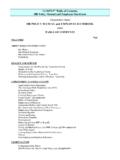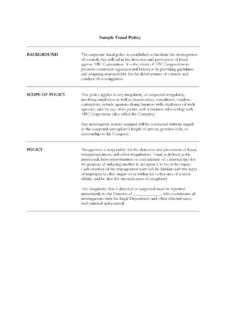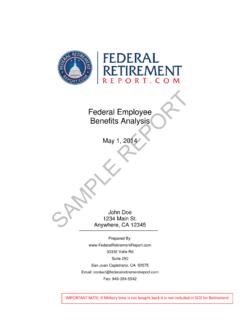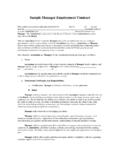Transcription of SAMPLE EMPLOYEE HANDBOOK - Stonetrust …
1 Effective January 1, 2008 These samples are provided because we believe that the key to controlling your workers compensation insurance costs begins with effective employment hiring and training practices. SAMPLE EMPLOYEE HANDBOOK __ (LOUISIANA) WARNING !!! This SAMPLE EMPLOYEE HANDBOOK is being furnished to you as a courtesy. Stonetrust highly recommends that you consult legal counsel before implementing the enclosed document for use in your operations. The enclosed is only a SAMPLE document to be used as a guide to assist you in developing your own EMPLOYEE HANDBOOK ; Stonetrust is not able to provide any warranties, express or implied, in regard to this documentation. This document is intended to help our policyholders create their own personnel policies and handbooks for distribution internally. You are encouraged to modify it to suit your organization.
2 You may not distribute this document to other organizations, either for profit or free of charge. Effective January 1, 2008 TABLE OF CONTENTS SECTION 1 - INTRODUCTION Changes in Policy Employment Application/Employment Information Update Employment Relationship SECTION 2 - DEFINITIONS OF EMPLOYEE STATUS Employees Defined SECTION 3 - EMPLOYMENT POLICIES Non-Discrimination Non-Disclosure/Confidentiality New EMPLOYEE Orientation Probationary Period for New Employees Office Hours Lunch Periods Breaks Personnel Files Personnel Data Changes Inclement Weather/Emergency Closings Performance Review and Planning Sessions Outside Employment Corrective Action Employment Termination Safety EMPLOYEE Requiring Medical Attention Building Security Insurance on Personal Effects Supplies; Expenditures.
3 Obligating the Company Expense Reimbursement Parking Visitors in the Workplace Immigration Law Compliance Effective January 1, 2008 SECTION 4 - STANDARDS OF CONDUCT Attendance/Punctuality Absence Without Notice Harassment/Discrimination Telephone Use Public Image Substance Abuse Tobacco Products/Smoking Policy Internet/Computer Use Solicitation Workplace Violence SECTION 5 - WAGE AND SALARY POLICIES Wage or Salary Increases Timekeeping Overtime Paydays SECTION 6 - BENEFITS AND SERVICES Insurance Cobra Benefits Social Security/Medicare Retirement Plan Paid Days Off Recordkeeping Holidays Jury Duty Military Leave Educational Assistance Training and Professional Development SECTION 7 - EMPLOYEE COMMUNICATIONS Staff Meetings Bulletin Boards Procedure for Handling Complaints Document Retention Effective January 1.
4 2008 SECTION 1 INTRODUCTION This HANDBOOK is designed to acquaint you with _____ (hereinafter the Company ) and provide you with information about working conditions, benefits, and policies affecting your employment. The information contained in this HANDBOOK applies to all employees of the Company. Following the policies described in this HANDBOOK is considered a condition of continued employment. However, nothing in this HANDBOOK alters an EMPLOYEE s at-will status. Unless specifically stated otherwise in writing, all _____ employees are at-will employees. This means that you may resign at any time, with or without cause. Similarly, the Company has the right to terminate your employment at any time, with or without cause. The contents of this HANDBOOK shall not constitute nor be construed as a promise of employment or as a contract between the Company and any of its employees.
5 The HANDBOOK is a summary of our policies, which are presented here only as a matter of information. You are responsible for reading, understanding, and complying with the provisions of this HANDBOOK and any policies you may receive. Our objective is to provide you with a work environment that is constructive to both personal and professional growth. CHANGES IN POLICY This HANDBOOK supersedes all previous EMPLOYEE Handbooks and memos that may have been issued from time to time on subjects covered in this HANDBOOK . Since our business and our organization are subject to change, we reserve the right to interpret, change, suspend, amend, cancel, or dispute with or without notice all or any part of our policies, procedures, and benefits at any time. We will notify all employees of these changes. Changes will be effective on the dates determined by the Company, and after those dates all superseded policies will be null.
6 No individual supervisor or manager has the authority to change policies at any time. If you are uncertain about any policy or procedure, speak with your direct supervisor. EMPLOYMENT APPLICATION/EMPLOYMENT INFORMATION UPDATE We rely upon the accuracy of information contained in the employment application, the employment information update, and the accuracy of other data presented throughout the hiring process and employment. Any misrepresentations, falsifications, or material omissions in any of this information or data may result in exclusion of the individual from further consideration for employment or, if the person has been hired, termination of employment. Employees are obligated to keep the Company updated on all contact and other personal information (such as status of marriage, beneficiaries, etc.) Effective January 1, 2008 EMPLOYMENT RELATIONSHIP You entered into your employment with _____ voluntarily, and you are free to resign at any time, for any reason or no reason.
7 Similarly, _____ is free to terminate its relationship with any EMPLOYEE at any time without reason and/or notice. Following the probationary period, employees are required to follow the Employment Termination Policy (see Section ). No EMPLOYEE is guaranteed employment through the probationary period. SECTION 2 DEFINITIONS OF EMPLOYEE STATUS EMPLOYEES DEFINED An EMPLOYEE of _____ is a person who regularly works for the Company for wages. Unless specifically stated otherwise in writing, all Company employees are at-will employees. Employees may include exempt, non-exempt, regular full-time, regular part-time, and temporary persons, and others employed with the Company who are subject to the control and direction of _____ in the performance of their duties.
8 Independent contractors are not employees of the Company. EXEMPT: Employees whose positions meet specific criteria established by the Fair Labor Standards Act (FLSA) and who are otherwise exempt from the minimum wage and overtime pay requirements. Exempt employees are paid a set salary, regardless of the number of hours that they work each workweek. Exempt employees may have whole-day deductions made from their weekly salary for personal leaves of absences, unpaid sick leave, or disciplinary suspensions, as well as other deductions permitted by state and federal law ( , FICA). The Company will not make any improper deduction(s) from the weekly salary of an exempt EMPLOYEE . If an EMPLOYEE believes an improper deduction has been made, he/she must immediately notify his/her direct supervisor. Any improper deduction will be reimbursed by the Company to the affected EMPLOYEE on the next regular payday.
9 NON-EXEMPT: Employees whose positions entitle them to minimum wage and overtime pay under the FLSA criteria and are paid one and one-half their regular rate of pay for hours worked in excess of 40 hours per workweek. REGULAR FULL-TIME: Employees who have completed the 90-day probationary period and who are regularly scheduled to work 40 or more hours per week. Generally, regular full-time employees are eligible for the Company s benefit package, subject to the terms, conditions, and limitations of each benefit program. REGULAR PART-TIME: Employees who have completed the 90-day probationary period and who are regularly scheduled to work less than 40 hours per week. Regular Effective January 1, 2008 part-time employees may be eligible for some, but not all, benefits sponsored by the Company, subject to the terms, conditions, and limitations of each benefit program.
10 TEMPORARY (FULL-TIME or PART-TIME): Those whose performance is being evaluated to determine whether further employment in a specific position or with the Company is appropriate or individuals who are hired as interim replacements to assist in the completion of a specific project or for vacation relief. Employment beyond any initially stated period does not in any way imply a change in employment status. Temporary employees retain that status until they are notified of a change. Temporary employees are not eligible for any of the Company s benefit programs. PROBATIONARY PERIOD FOR NEW EMPLOYEES: A new EMPLOYEE whose performance is being evaluated to determine whether further employment in a specific position or with _____ is appropriate. If a probationary EMPLOYEE completes the probationary period, the EMPLOYEE will be notified of his/her new status with the Company.










